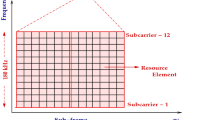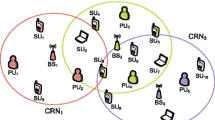Abstract
This research article has been conducted for the efficient use of frequency spectrum in multi-RAT cellular network using dynamic spectrum refarming (DSR). For this purpose, two overlapping networks, GERAN and EUTRAN, and their voice and data traffic statistics are taken into consideration. Our investigation of hourly traffic changes in the voice service in the GERAN and the data service in the EUTRAN (which are the dominant services of each of these networks), indicates that these changes are approximately orthogonal. This issue is the main motivation for use of DSR methods, including DSR without inband/guardband (I/G) overlay and DSR with I/G overlay, for efficient assignment of frequency resources to GERAN and EUTRAN. In this paper, the main focus is on the process of performing DSR with I/G overlay in a real network and its challenges. For this purpose, we used a nonlinear autoregressive neural network to predict the traffic changes of voice service in the GERAN. By this method, the prediction error is less than 6.5% in the peak hours. Also, a method for efficient use of GERAN and EUTRAN carrier numbers (ARFCN and EARFCN, respectively) has been proposed to reduce the mutual interference in DSR with I/G overlay. The results show the significant impact of the DSR with I/G overlay on increasing the EUTRAN average bit rate compared to the classic spectrum refarming method (168% in downlink and 146% in uplink).










Similar content being viewed by others
References
Cisco. (2017). Cisco visual networking index: Global mobile data traffic forecast update, 2016–2021, white paper.
Akpakwu, G. A., Silva, B. J., Hancke, G. P., & Abu-Mahfouz, A. M. (2018). A survey on 5G networks for the internet of things: Communication technologies and challenges. IEEE Access, 6, 3619–3647. https://doi.org/10.1109/ACCESS.2017.2779844.
Danaei-Yeganeh, F., & Ebrahimi, A. (2016). Management of cell re-selection in 3GPP cellular networks and analysis of two challenges of an Iranian operator. Tabriz Journal of Electrical Engineering, 46(3), 161–179.
Wu, L., & Sandrasegaran, K. (2012). A study on radio access technology selection algorithms. Berlin: Springer.
Liang, Y. C., Chen, K. C., Li, G. Y., & Mahonen, P. (2011). Cognitive radio networking and communications: An overview. IEEE Transactions on Vehicular Technology, 60(7), 3386–3407. https://doi.org/10.1109/TVT.2011.2158673.
Hu, F., Chen, B., & Zhu, K. (2018). Full spectrum sharing in cognitive radio networks toward 5G: A survey. IEEE Access, 6, 15754–15776. https://doi.org/10.1109/ACCESS.2018.2802450.
He, X., Jiang, H., Song, Y., Luo, Y., & Zhang, Q. (2018). Joint optimization of channel allocation and power control for cognitive radio networks with multiple constraints. Wireless Networks. https://doi.org/10.1007/s11276-018-1785-1.
Szydelko, M., & Dryjanski, M. (2016). Spectrum toolbox survey: Evolution towards 5G. In International conference on cognitive radio oriented wireless networks (pp. 703–714). Springer.
Han, S., Liang, Y. C., Soong, B. H., & Li, S. (2016). Dynamic broadband spectrum refarming for OFDMA cellular systems. IEEE Transactions on Wireless Communications, 15(9), 6203–6214. https://doi.org/10.1109/TWC.2016.2581813.
Han, S., Liang, Y. C., & Soong, B. H. (2015). Spectrum refarming: A new paradigm of spectrum sharing for cellular networks. IEEE Transactions on Communications, 63(5), 1895–1906. https://doi.org/10.1109/TCOMM.2015.2418196.
Bansal, G., Hossain, M. J., Bhargava, V. K., & Le-Ngoc, T. (2013). Subcarrier and power allocation for OFDMA-based cognitive radio systems with joint overlay and underlay spectrum access mechanism. IEEE Transactions on Vehicular Technology, 62(3), 1111–1122. https://doi.org/10.1109/TVT.2012.2227856.
Lin, X., & Viswanathan, H. (2013). Dynamic spectrum refarming with overlay for legacy devices. IEEE Transactions on Wireless Communications, 12(10), 5282–5293. https://doi.org/10.1109/TWC.2013.092313.130227.
Lin, X., & Viswanathan, H. (2013). Dynamic spectrum refarming of GSM spectrum for LTE small cells. In 2013 IEEE Globecom workshops (GC Wkshps) (pp. 690–695). https://doi.org/10.1109/GLOCOMW.2013.6825068.
3GPP. (2005). Technical specification group GSM/EDGE; radio access network; radio transmission and reception (Release 1999). Technical specification (TS) 5.05, 3rd generation partnership project (3GPP), version 8.20.0.
3GPP. (2014). LTE; evolved universal terrestrial radio access (E-UTRA); user equipment (UE) radio transmission and reception (Release 12). Technical specification (TS) 36.101, 3rd generation partnership project (3GPP), version 12.05.0.
3GPP. (2015). Technical specification group radio access network; study on multiple radio access technology (Multi-RAT) joint coordination (Release 13). Technical report (TR) 37.870, 3rd generation partnership project (3GPP), version 13.0.0.
Hahn, S., Altman, Z., & Amirijoo, M. (2015). D6.6-Final report on a unified self-management system for heterogeneous radio access networks. Report, European Commission. http://www.fp7-semafour.eu/en/public-deliverables/.
MCI. (2017, 2019). Cellular network traffic database. http://fa.ee.sut.ac.ir/Downloads/CNTDB.zip.
3GPP. (2014). Technical specification group radio access network; E-UTRA, UTRA and GSM/EDGE; multi-standard radio (MSR) base station (BS) radio transmission and reception (Release 10). Technical specification (TS) 37.104, 3rd generation partnership project (3GPP), version 10.14.0.
Ericsson. (2008). Ericsson launches groundbreaking multi-standard radio base stations. Press releases. http://www.ericsson.com/news/1190063.
3GPP. (2011). Technical specification group radio access network; evolved universal terrestrial radio access (E-UTRA); base station (BS) radio transmission and reception (Release 10). Technical specification (TS) 36.104, 3rd generation partnership project (3GPP), version 10.2.0.
Kliks, A., Musznicki, B., Kowalik, K., & Kryszkiewicz, P. (2018). Perspectives for resource sharing in 5G networks. Telecommunication Systems, 68(4), 605–619. https://doi.org/10.1007/s11235-017-0411-3.
Wang, R., Hu, H., & Yang, X. (2014). Potentials and challenges of C-RAN supporting multi-RATs toward 5G mobile networks. IEEE Access, 2, 1187–1195. https://doi.org/10.1109/ACCESS.2014.2360555.
Vassilakis, V. G., Moscholios, I. D., & Logothetis, M. D. (2018). Efficient radio resource allocation in SDN/NFV based mobile cellular networks under the complete sharing policy. IET Networks, 7(3), 103–108. https://doi.org/10.1049/iet-net.2017.0053.
Ratasuk, R., Mangalvedhe, N., Zhang, Y., Robert, M., & Koskinen, J. P. (2016). Overview of narrowband IoT in LTE Rel-13. In 2016 IEEE Conference on standards for communications and networking (CSCN) (pp. 1–7).
3GPP. (2018). LTE; evolved universal terrestrial radio access (E-UTRA); user equipment (UE) radio transmission and reception (Release 13). Technical specification (TS) 36.101, 3rd generation partnership project (3GPP), version 13.11.0.
3GPP. (2016). Technical specification group radio access network; evolved universal terrestrial radio access (E-UTRA); base station (BS) radio transmission and reception (Release 13). Technical specification (TS) 36.104, 3rd generation partnership project (3GPP), version 12.05.0.
3GPP. (2010). Technical specification group radio access network; evolved universal terrestrial radio access (E-UTRA); physical channels and modulation (Release 10). Technical specification (TS) 36.211, 3rd generation partnership project (3GPP), version 10.0.0.
Forsk. (2014). Atoll 3.2.1 User manual, Forsk, January 2014. http://www.forsk.com/support.
Cui, D. (2009). LTE peak rates analysis. In: 2009 18th annual wireless and optical communications conference. (pp 1–3). IEEE. https://doi.org/10.1109/WOCC.2009.5312788.
Müllner, R., Ball, C., Ivanov, K., Winkler, H., Perl, R., & Kremnitzer, K. (2005). Dynamic half-rate allocation for adaptive multi-rate speech codecs in GERAN radio networks. In Proceedings of 14th IST mobile and wireless communications summit.
Acknowledgements
Hereby, we wish to express our gratitude to Design and Optimization Department in EATC Company who helped in conducting this study by providing traffic measurement data.
Author information
Authors and Affiliations
Corresponding author
Additional information
Publisher's Note
Springer Nature remains neutral with regard to jurisdictional claims in published maps and institutional affiliations.
This work was supported in part by the Technology and Research Vice Chancellor at Sahand University of Technology, under contract 30/7906.
Rights and permissions
About this article
Cite this article
Danaei Yeganeh, F., Ebrahimi, A. Dynamic spectrum refarming for GERAN/EUTRAN considering GERAN voice traffic. Telecommun Syst 73, 507–520 (2020). https://doi.org/10.1007/s11235-019-00625-0
Published:
Issue Date:
DOI: https://doi.org/10.1007/s11235-019-00625-0




